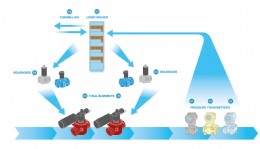Getting to Grips with HIPPS




Oil and gas production facilities and processing plants are facing demands to deliver higher flow rates and throughput. They need to achieve this without compromising safety, in the face of tightening environmental constraints. This trend has initiated the rise of High Integrity Pressure Protection Systems (HIPPS) as the ultimate protection system for both new and existing installations. However, the perceived complexity and cost can be a barrier to uptake. It is worth taking a closer look at HIPPS though. When the systems are expertly specified, designed and integrated, their deployment can bring multiple, long-lasting gains over and above the immediate environmental benefits.
Safety system trends
HIPPS offer a sophisticated valve-based safety instrumented system (SIS) to protect equipment from over-pressurisation. In a hydrocarbon production and processing environment they act as a barrier between high-pressure upstream and low-pressure downstream sections of an installation.
In extreme scenarios, over-pressurisation can result in the full emergency shutdown of a plant. This procedure can have a significant economic impact, bringing subsequent loss of production and increased maintenance costs. Traditionally, over-pressurisation is dealt with through simple relief or flare systems. When pressure builds up to a certain point, a relief valve opens enabling the gas or fluid to escape. The objective is to minimise damage and danger. However, in reality the released medium can be flammable, toxic, or both. Lack of containment can be catastrophic in terms of human safety and the environment.
Using HIPPS instead of a pressure relief system significantly enhances a plant’s safety and environmental credentials. Rather than removing the excess gas or fluid once a defined pressure has been exceeded, it is triggered at an earlier stage. The source of high pressure is shut off before over-pressurisation occurs, avoiding the need for venting. HIPPS cut off the inflow of excess media and contain it in the system through the rapid deployment of two in-series safety shut off valves/ actuators (final elements). Once activated, these final elements automatically shut off and isolate the high pressure source.
Installations that have to comply with strict environmental regulations have been the forerunners in development and uptake of HIPPS. It can be the only feasible option in scenarios where environmental restrictions limit the use of traditional relief systems that involve emissions. The reliability of HIPPS in preventing downstream overpressure makes it a superior option from a safety perspective also. It can provide a valuable solution in situations where extremely high pressures are involved or when the required sizing of a relief valve is difficult to define.
There are also significant economic advantages associated with HIPPS that are often overlooked. As an emergency response solution, HIPPS deployment is far less costly than a lengthy emergency shutdown and all the repercussions that entails. What’s more, using HIPPS in a pipeline unlocks the potential for lower design pressures downstream of the HIPPS.
This facilitates a reduction in required wall thickness for assets, allowing for derated pipework to be utilised downstream, bringing potential size, weight and cost advantages, as well as having a positive impact on flow rates and throughput.
So while environmental requirements have been the core driver of HIPPS, there are in fact three scenarios where the systems can offer an effective solution. If the surrounding environment needs to be protected, the economic viability of a development needs to be improved or the risk profile of a plant needs to be reduced, HIPPS should be brought to the table as a potential alternative to simple relief systems. HIPPS are equally effective in new projects or when adding to or upgrading existing installations.
Safety Integrity Levels
Like all safety instrumented systems intended to protect equipment, personnel and environment, HIPPS are designed and built in accordance with standards set by the International Electrotechnical Commission (IEC). Two performance based, non-prescriptive standards, IEC 61508 and IEC 61511, are applicable to HIPPS. When HIPPS are deployed appropriately in line with these standards, the fundamental concepts are integrated with the total lifecycle of a plant’s overall safety system. Together, the standards provide a framework and lifecycle approach for design, implementation and management where the level of risk definition varies between sectors.
The core standard, IEC 61508, is geared towards electrical, electronic or programmable safety-related systems. It also provides a framework for safety-related systems based on other technologies including mechanical systems. The additional IEC 61511 provides structure for designers, integrators and users of safety instrumented systems. It covers the wider parts of the safety loop, such as the sensors and final elements, in more detail. Importantly IEC 61511 is more specific for use in the Process Industry.
Each HIPPS design is rooted in a safety integrity level (SIL) specific to the individual process application. Levels are represented by a simple number scheme, 1 to 4, where 4 equates to the highest level of required dependability. This approach enables senior managers and decision makers to discuss safety integrity systems with engineering teams without requiring a detailed understanding of the technical aspects. However, without due diligence, it can lead to over-simplification and a tendency to over-specify systems by erring on the side of caution. Since HIPPS are seen as an alternative to safety relief systems, there is a common misconception that the SIL requirement must be high. However, more rigorous interpretation of SIL assessment workshops will identify the actual necessary SIL requirements which, in fact, may be lower (or even higher) than first thought. Opting for the correct SIL rating has significant benefits as it not only ensures that the safety and environmental impacts are fully satisfied but it enables the appropriate performance standards and testing frequency to be set at the correct level with potential economic benefits.
A best practice approach involves the intelligent evaluation of systems in order to allocate the most appropriate SIL. The level is defined following a detailed risk analysis (HAZOP) of the entire plant and the individual process, providing a benchmark for the required risk reduction. It is the end user’s responsibility to ensure consistent and appropriate SIL assignments by establishing a robust risk management philosophy and risk tolerance. Working alongside independent functional safety professionals as early as possible will ensure a robust engineered solution.
In a gas plant context, the European standard EN12186 and more specifically EN14382 prescribe the requirements for the over-pressure protection systems, and their components. The response time and accuracy of the loop as well as safety factors for over-sizing of the actuator are dictated by these standards. Independent design verification and testing to prove compliance to the EN14382 standard is mandatory. Users often refer to this standard for HIPPS design.
HIPPS components
HIPPS is an application-specific safety system best represented as a complete functional loop that typically consists of three fundamental components:
1. Pressure Transmitters monitor the pipeline pressure against a predefined limit. Defining the number and types of transmitters and their voting systems is a function of the SIL rating. In an electronic HIPPS, pressure transmitters are configured for ‘twoout- of-three’ (2oo3) voting.
2. A Logic Solver captures signals from the pressure transmitters and performs a 2oo3 voting logic before deenergising the solenoids and closing the final elements.
3. The final elements comprise two shutoff valves and actuators in series (for SIL 3) each fitted with two dissimilar solenoids. The solenoids are optimised to provide fast, reliable stroking or partial stroke testing over an extended service life and activate the final two shut-off valves in the loop which provide the corrective action to bring the process to a safe state.
This configuration ensures a high degree of redundancy to enhance system performance and reliability. The 2oo3 methodology enhances the system’s ability to detect a problem when it occurs, while reducing the likelihood of a response being accidentally triggered when there isn’t a problem. Should one of the three pressure transmitters fail, it will not compromise functionality as two high pressure readings are required for activation. Likewise, if one of the valves in the final element fails, the second valve acts as a back up to maintain the isolation of the high pressure source.
Dedicated HIPPS integration
Clearly, in an ideal world there would never be a need for safety systems to be activated. Plant designers and engineers should continually strive for inherent safety. Holistic thinking and intelligent design reviews are essential to get the most out of HIPPS. They are the last line of defence and shouldn’t be used as an alternative to designing out potential over-pressurisation problems.
Projects that don’t allow adequate time for critical assessment upfront can result in plants having a HIPPS with an inappropriate SIL specified. This can result in the installation either continuing to rely on emergency shutdown valves or failing to realise the full benefits of HIPPS if they are installed. Ascertaining the correct SIL assignment at the outset is a critical success factor, and this should form the central driver for system design and decision making.
Choosing an independent HIPPS integrator that has the freedom to draw on the best technologies in the market to meet specific needs of an individual plant application is an effective route. The depth and breadth of their specialist HIPPS expertise can underpin innovative approaches with a superior level of reliability. For instance, the expert selection of components from various manufacturers can reduce the potential for a ‘common cause factor’ resulting in system failure. While it is good practice to use two final elements in the loop to enhance redundancy, they are generally two valves of the same type from the same manufacturer. Opting for two different valve designs (i.e. gate valve and ball valve) from independent suppliers is the surest way to maximise redundancy and enhance overall safety.
There’s no denying that HIPPS are complex and challenging. Ideally, their development and integration should draw on the combined expertise of electronic and software engineers as well as mechanical engineers. These experts need to work cohesively with functional safety management professionals to interrogate the design brief and look in detail at SIL requirements. Therefore, it is a best practice approach to engage with an independent integrator who can not only offer all of these required professionals in-house but has a robust functional safety management system in place and a competency management system which ensures that the required professionals are trained and certified to exceed the required industry standards.
Using such a business model makes sure that all the requirements of the HIPPS integration can be put into place with a single point of contact, easing communication throughout planning, development and delivery, reducing the time lost by removing the necessity for constant liaison with several third parties. In addition to this ‘one-stop-shop’ approach external third party professional consultation can support the project in a validation role at agreed specific milestones throughout the project, this makes for a structured, cost and time saving approach.
A collaborative approach between the end user and an independent HIPPS integrator can facilitate the creation of an innovative and effective long term solution. Opting for best-in-class, expertled protection of equipment that could be susceptible to over-pressurisation brings multiple benefits. Enhanced safety and environmental credentials go hand-in-hand with considerable economic advantages. For more information contact Robert Walker on +44(0)7884 658 078 or robert.walker@ severnglocon.co.uk.
Tel: +44 (0)845 223 2040
Email: sales@severnglocon.co.uk
Web: www.severnglocon.com
Published: 13th May 2016
Rachel Wormald, Managing Director at YPS Valves Ltd and Elizabeth Waterman, ...
Are you looking for industry-leading, brand independent valve and actuator ...
As can be seen from the photograph, clearly the resident birds at Bartlett ...
Howco Group has unveiled its latest £1million investment, with the ...
In 2024, Allvalves is poised for an exciting year of growth and expansion, ...
GMM Pfaudler Engineered Plastics & Gaskets are delighted to bring the ...
In the ever-evolving valve industry, GMM Pfaudler stands out for its ...
SAMSON Controls Ltd – part of the SAMSON group - a renowned leader in ...










